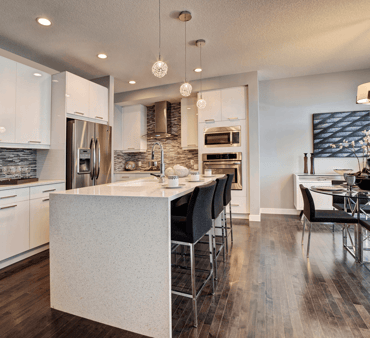 The open concept floor plan—it’s the latest design trend, but is it the right one for you? While today’s designers tout the benefits of open concept living spaces, before you decide to knock out a load-bearing wall, consider the pros and cons.
The open concept floor plan—it’s the latest design trend, but is it the right one for you? While today’s designers tout the benefits of open concept living spaces, before you decide to knock out a load-bearing wall, consider the pros and cons.
The Pros of Open Concept Living
Brings Family and Friends Together
Opening up a space can breathe new life into any home. Instead of partitioning an interior into small compartmentalized rooms that tend to isolate family and guests, removing a wall can help bring the people together and provide hours of quality family time. The key is to creatively design your space to combine free form with function. Group designated seating for entertaining large crowds or watching television and smaller spaces for quiet reading or personal lounging.
Let's the Sunshine In
If your current house tends to be dark and dreary, choosing an open concept floor plan will let natural sunlight in and help reduce energy bills. During those cold Calgary winter months, extra light is a definite plus – warming up cold, damp rooms and brightening the space. Brighter, lighter rooms also beat the winter blues and boost morale.
 Creates an Illusion of Space
Creates an Illusion of Space
Because a house without walls looks larger and frees up the flow of traffic, open concept floor plans create the feeling of having more space. There are no walls to confine guests or block the view from room to room. Open spaces are more liberating and offer flexible options for entertaining a crowd.
Increases Sight Lines and Child Safety
Everyone knows how quickly tots who are too quiet can get into trouble if left unsupervised. An open floor plan increases sight lines and lets mom keep an eye on the children while preparing dinner. Little ones have fewer chances to get into mischief and more time to interact with parents nearby.
More Space Means More Design Options
Extra space means more room to spread out. Add a sectional, an over-sized flat panel TV, or seating in the round! Larger scaled furnishings will feel right at home in a space without confining walls.
Cons of Open Floor Plans
More Sunlight Means More Heat
While natural sunlight is a plus on cold winter days, all the extra sunshine can bring extra heat and higher cooling bills. Furniture exposed to sunlight can also fade or absorb heat, putting you and your guests in the hot seat!
Open Spaces Are Harder to Heat
A lack of walls can create a drafty space that may be difficult to heat efficiently. There's nothing to block winter drafts from moving across an open foyer and into living spaces. A lack of wall space also limits design options. Where do you put the flat panel TV or your favourite family portrait?
No Walls Can Make a Lot of Noise
It's no secret that interior walls help insulate and cut down on noise. Sound will carry throughout the main floor in an open layout, so keep this in mind if you have children who like to play and guests to entertain.
Open Spaces Create Open Messes
Unless you’re only preparing light snacks or warming a meal, an open concept kitchen means messy pots and pans, dirty dishes and raw food in varying stages of preparation are constantly visible to family and friends. Keeping the kitchen clean becomes a constant chore--one that is unnecessary when you can hide chores for tomorrow behind a wall.
When it comes to deciding whether to design an open or closed floor plan, ultimately, it depends on several factors. Consider your overall lifestyle, cooking and cleaning habits, or relative need for privacy and go with your personal preference. Weigh all your options and don’t be afraid to try new solutions to make your space work for you!





